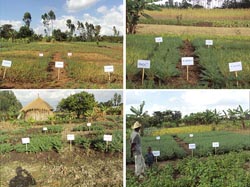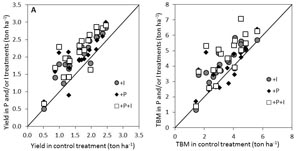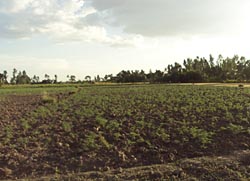Ethiopia recently joined the N2Africa project. The country is the leading chickpea producer in Africa with a share of 39% of the total production in 2011. In the same year, chickpea was the third most widely cultivated legume crop in Ethiopia next to faba bean and haricot bean. Reason enough to include chickpea as one of the focus crops of N2Africa in this country. Chickpea, being considered a multi-functional crop, has an important role in Ethiopian diets and serves as a protein source for the rural poor who cannot afford to buy animal products. The crop also generates cash and plays a major role in Ethiopia’s foreign exchange earnings through export to Asia and Europe. Nonetheless, despite of its potential to produce about 3 ton ha-1, the average productivity of chickpea in Ethiopia for 2011 was only 1.6 ton ha-1 (FAOSTAT 2012).
To investigate how chickpea productivity can be increased, a study was conducted to evaluate the response of chickpea to inoculants, P fertilizer and their combined application on farmers’ fields in Wolaita area in southern Ethiopia.
Materials and methods
Wolaita area is located at about 350 km south west of Addis Ababa, the capital city of Ethiopia. In this area, chickpea is one of the most important grain legumes produced by small-scale farmers and it serves as a source of food and cash. Given its ability to grow on residual moisture, chickpea allows farmers to produce an extra crop each year. In Wolaita area, agriculture is dominated by subsistence farming where limited usage of improved technologies and agricultural inputs significantly limits productivity and per capita income. A very high population density of up to 746 persons per square kilometre has reduced the average land holding of the area to about 0.25 to 1 ha per household (Jufare 2008).
Experiments were conducted on twenty farmers’ fields in Wolaita zone from September 2012 to January 2013. Two contrasting soil types (i.e. black and red) were compared. For this experiment, Mesorhizobium ciceri strain CP 41 was obtained from the soil microbiology laboratory of the School of Plant and Horticultural Sciences, Hawassa University and used along with Natoli variety chickpea. The work was done by a Plant Sciences MSc student of Wageningen University, Ibsa Aliyi (Fig. 1), with close supervision of Dr. Katrien Descheemaeker, Prof. dr. Ken Giller and Dr Endalkachew Wolde-meskel, and was financed by the N2Africa project.
|
Figure 1: Ibsa in one of the experimental fields |
Figure 2: Across farm variability of growth of chickpea |
Results
Despite the large variability across farms (Fig. 2), inoculation and P fertilizer significantly improved nodulation, growth and yield of chickpea compared with the control. The combined application of inoculation and P resulted in an even more pronounced improvement. As far as grain yield is concerned, positive effects of the soil fertility treatments were recorded on about 85% of the farms (Fig. 3A). As such, inoculation, P and their combined application increased grain yield of chickpea by 26%, 19% and 33% over the control respectively.
The total biomass of chickpea is of great importance in farm level nutrient cycling due its role as either animal feed or organic matter to be returned to the soil. In this study, total biomass of chickpea was significantly improved by the soil fertility treatments (Fig. 3B) due to the positive effects of nitrogen and phosphorus on vegetative growth, and the synergy of these two nutrients on plant growth. The importance of inoculation was also confirmed by the fact that the soils of the study area were inhabited by a very small population of resident rhizobia (< 10 gram-1 of soil).
|
Figure 3: Response of chickpea grain yield (A) and total biomass (B) (ton ha-1) to inoculation and/ or phosphorus fertilization treatments. Notes: +I = inoculation, +P = phosphorus fertilized, +P+I = both inoculation and P fertilization, TBM = total biomass |
Figure 4: Widely spaced chickpea planting on a farmers’ field, Taba |
Generally, the observed improvement in chickpea performance can be attributed to the increased supply of nitrogen, through enhanced biological nitrogen fixation, and phosphorus, which were both present in low supply in the soils. As was observed during our field visits, most of the farmers sow chickpea in very low density (Fig. 4), which was due to lack of sufficient seed during planting time and resulted in under-exploitation of the land. Furthermore, most of the farmers in this area cannot afford P fertilizers, so credit facilities or direct supply of fertilizer would be necessary.
Assuming chickpea is planted on a quarter of the 0.6 ha landholdings of the households, inoculation, P fertilization, and P+I would enable a crop production increment of 60 kg, 45 kg and 75 kg per farm respectively. This corresponds to a net benefit of 63, 33, and 63 USD for using inoculation, P fertilization, and P+I treatments respectively with no difference in return between inoculation and P+I treatments.
Ibsa Aliyi Abdula, MSc Plant Sciences, Wageningen University




